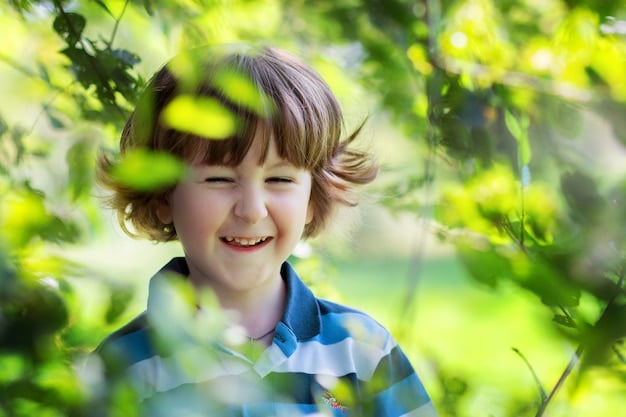Decoding Temperament: Understanding Your Child’s Unique Personality

A child’s temperament, the inherent way they approach and react to the world, significantly shapes their personality and behavior, underscoring the importance of parental understanding and responsive support for optimal development.
Every child is a unique individual, blooming with their own set of characteristics and ways of interacting with the world. This inherent nature, often referred to as child temperament, plays a foundational role in shaping their personality, responses, and overall development. Understanding this fundamental aspect enables parents to foster a nurturing environment where their child can thrive.
The Foundational Concept of Temperament in Child Development
Temperament is not learned behavior; rather, it’s a biologically based set of traits that influence how a child reacts to the world around them. It’s the “how” of behavior, not the “what” or “why.” For instance, two children might both exhibit sadness, but one might express it through quiet withdrawal, while the other might have a loud, dramatic outburst. These differing expressions are rooted in their inherent temperaments.
Delving into temperament helps us move beyond simply labeling a child as “shy” or “naughty.” Instead, it encourages a deeper exploration into the underlying characteristics that predispose a child to certain behaviors. This perspective transforms parental responses from frustration to understanding, paving the way for more effective support strategies.
Historical Context and Key Theories
The study of temperament has a rich history, with significant contributions from various researchers. Early pioneers like Hippocrates linked temperament to bodily fluids, while more modern psychological theories provide a more scientific framework. The most influential work comes from the New York Longitudinal Study (NYLS) conducted by Drs. Alexander Thomas and Stella Chess in the 1950s.
-
The New York Longitudinal Study (NYLS)
Thomas and Chess observed hundreds of children from infancy through adulthood, identifying nine core characteristics of temperament. Their groundbreaking research showed that these dimensions were largely stable over time, though they could be influenced by environmental factors and parental responsiveness.
- Activity Level: The proportion of active periods to inactive ones.
- Rhythmicity: The predictability or unpredictability of biological functions like hunger and sleep.
- Approach/Withdrawal: How a child responds to new stimuli.
- Adaptability: How easily a child adjusts to changes.
- Intensity of Reaction: The energy level of a child’s responses.
- Threshold of Responsiveness: The intensity of stimulation required to evoke a response.
- Quality of Mood: The child’s general disposition (positive, negative, or a mix).
- Distractibility: The ease with which a child can be diverted from an activity.
- Attention Span/Persistence: The length of time a child can focus on an activity and their ability to stay with it despite obstacles.
Understanding these nine dimensions offers parents a language to describe their child’s unique makeup, moving beyond vague labels. For instance, a child labeled “difficult” might simply have low rhythmicity, high intensity of reaction, and slow adaptability. Recognizing these nuances empowers parents to respond with empathy and tailored strategies, rather than imposing expectations that go against a child’s natural wiring. This framework underscores that temperament is neither good nor bad; it simply describes a child’s inherent style.
Identifying Your Child’s Temperamental Style
Recognizing your child’s temperamental style is the first step towards effective parenting. While every child is unique, Thomas and Chess identified three broad categories that help simplify understanding, though children rarely fit perfectly into just one. These categories serve as useful benchmarks for observation.
The Three Major Temperamental Classifications
- The Easy Child (Approximately 40%): These children are generally positive in mood, adaptable to new situations and routines, and have regular biological rhythms. They are often easy to soothe and respond well to novelty. Parents often describe them as “a joy to be around.”
- The Difficult Child (Approximately 10%): Often misunderstood, children with this temperament tend to withdraw from new situations, are slow to adapt, and have irregular biological rhythms. Their reactions are often intense and negative in quality. They may cry loudly, resist change, or struggle with transitions. This temperament is often the most challenging for parents to manage, as it requires significant patience and consistent strategies.
- The Slow-to-Warm-Up Child (Approximately 15%): These children are characterized by a low activity level, tend to withdraw from new situations, and are slow to adapt. Unlike “difficult” children, their reactions are typically mild to moderate in intensity and they may have a somewhat negative mood. They need more time to adjust to new experiences or people but eventually adapt. They might seem shy or reserved initially.
It’s important to remember that these classifications are broad generalizations. Many children exhibit a mix of these characteristics, and approximately 35% don’t fit neatly into any single category. The goal isn’t to label a child but to understand the specific temperamental traits they exhibit.

Observation and Reflection: Your Parenting Toolkit
Parents are often the best observers of their children. By paying close attention to daily interactions and typical reactions, you can begin to pinpoint your child’s temperamental traits. Consider keeping a journal for a week, noting down specific instances and your child’s responses to them. Ask yourself:
- How does my child react to new foods, places, or people?
- What are their sleep and eating patterns like? Are they predictable or unpredictable?
- When they’re upset, how do they express it? Is it a mild whimper or a dramatic wail?
- How long does it take for them to adjust to a change in routine?
- What activities hold their attention best? What easily distracts them?
These observations provide valuable insights into their unique profile, helping you move beyond superficial judgments. Understanding your child’s core temperament allows you to anticipate needs and prevent conflict. It empowers you to build a stronger connection by respecting their inherent self, rather than trying to fit them into a preconceived mold.
The Goodness of Fit: Matching Parenting to Temperament
The concept of “goodness of fit” is paramount in understanding how a child’s temperament interacts with their environment, particularly with their parents. Coined by Thomas and Chess, it refers to the compatibility between a child’s temperament and the demands and expectations of their surroundings. A good fit occurs when environmental demands and expectations are congruent with the child’s temperamental style, allowing them to thrive. Conversely, a poor fit can lead to stress, frustration, and behavioral challenges.
Creating Congruence: Strategies for Positive Interaction
Achieving goodness of fit doesn’t mean changing your child’s temperament, which is largely innate. Instead, it involves adjusting your parenting style, expectations, and the environment to better suit your child’s unique makeup. This adaptability from the parent’s side is crucial for a child’s healthy development and self-esteem.
- For the “Difficult” Child:
- Predictable Routines: Establish consistent schedules for sleep, meals, and play to help with their struggle with irregularity.
- Gradual Introductions: When introducing new situations or people, do so slowly and allow them time to warm up. Don’t push them into immediate engagement.
- Prepare for Transitions: Give advanced warnings about changes and describe what will happen next. Use visual cues if helpful.
- Empathy and Patience: Their intense reactions are not intentional defiance. Acknowledge their feelings (“I see you’re really upset about this”) and remain calm.
- Channel Energy: Provide outlets for intense energy, whether it’s active play or creative expression.
- For the “Slow-to-Warm-Up” Child:
- Respect Their Pace: Understand they need more time to observe and process before engaging. Avoid pressuring them.
- Gentle Encouragement: Offer reassuring words and opportunities to join in, but respect their choice if they decline initially.
- Practice New Situations: Role-play or talk about upcoming events to help them mentally prepare.
- Build Confidence: Praise their small steps towards adaptation. Focus on their courage, not just their shyness.
- Create Safe Spaces: Ensure they have a quiet corner or a familiar comfort item in new environments.
- For the “Easy” Child:
- Avoid Over-Scheduling: While adaptable, even easy children can become overwhelmed by too many activities.
- Challenge Them Appropriately: Ensure they are stimulated and engaged, as their adaptability can sometimes hide a need for new experiences.
- Acknowledge Their Feelings: Even if they rarely show emotional distress, teach them to express their feelings and validate their experiences.
- Prevent Dependence: Teach them problem-solving skills, rather than always solving things for them.
The beauty of goodness of fit is in its recognition of individuality. It moves away from a one-size-fits-all parenting approach and instead advocates for a personalized strategy that honors who your child inherently is. When parents adjust their style to fit their child’s temperament, it fosters a stronger parent-child bond, reduces behavioral problems, and promotes a child’s healthy emotional and social development.
Temperament vs. Personality: Demystifying the Concepts
While often used interchangeably in casual conversation, “temperament” and “personality” are distinct psychological constructs. Understanding their differences is crucial for appreciating the developmental trajectory of a child. Temperament is foundational, biologically rooted, and appears early in life, forming the cornerstone upon which personality is built.
Defining the Distinctions
Temperament: As established, temperament refers to the consistent individual differences in mood, reactivity, and self-regulation. It is thought to have a strong genetic or biological basis and is observable from infancy. Think of it as the basic color palette a child is given at birth—red, blue, yellow—which influences the overall tone of their artistic creation.
- Early Emergence: Evident from birth or early infancy.
- Biological Basis: Largely genetic and neurobiological.
- Stable: Tends to remain relatively consistent over time.
- “How” of Behavior: Describes the style or manner of behavior (e.g., how intensely do they react?).
Personality: Personality, on the other hand, is a broader and more complex concept. It encompasses an individual’s characteristic patterns of thinking, feeling, and behaving. Personality develops over time through the dynamic interplay of temperament, environment (including family, culture, and experiences), and learning. Using our previous analogy, if temperament is the color palette, personality is the masterpiece painted using those colors, influenced by the canvas (environment) and the artist’s technique (learning and experiences).
- Later Development: Fully forms later and continues to evolve throughout life.
- Environmental Influence: Heavily shaped by experiences, learning, and social interactions.
- Flexible: Can change and adapt more over time than temperament.
- “What” and “Why” of Behavior: Describes the content and motivation behind behavior (e.g., what beliefs drive their actions? Why do they choose certain paths?).
While temperament is a significant contributor to personality, it does not solely determine it. Environmental factors, such as parenting styles, cultural norms, peer interactions, and significant life events, all play a powerful role in shaping how those innate temperamental traits are expressed and elaborated into a full personality. A child with a “slow-to-warm-up” temperament, for example, might develop a shy personality in a less supportive environment but could become a thoughtful and observant individual in a nurturing one. The key lies in the interaction between nature and nurture.

Temperament and Sibling Dynamics: Nurturing Each Individual
Any parent with more than one child quickly realizes that siblings, despite sharing genes and a common environment, are often remarkably different. These differences are largely attributed to their inherent temperaments. Understanding how distinct temperaments interact within a family unit is crucial for fostering healthy sibling relationships and ensuring each child feels seen and supported.
Navigating Diverse Temperaments within the Family
When one child is “easy” and the other “difficult,” or one “active” and the other “mellow,” parenting becomes a delicate balancing act. Parents might unwittingly favor the “easier” child, leading to feelings of inadequacy or resentment in the “more challenging” one. Conversely, the “difficult” child might demand more parental attention, leaving the “easy” child feeling overlooked. Here are strategies to navigate these dynamics:
- Avoid Comparisons: This is perhaps the most critical rule. Constantly comparing siblings, even implicitly, can damage self-esteem and fuel sibling rivalry. Each child should be celebrated for their unique strengths and contributions.
- Individualized Attention: Ensure each child receives dedicated, one-on-one time that caters to their specific interests and temperamental needs. The “active” child might benefit from a vigorous play session, while the “introverted” child might prefer quiet reading time.
- Acknowledge Differences: Talk openly, when appropriate, about how people are different and that these differences are valuable. Explain that everyone has their own way of doing things or reacting.
- Perspective-Taking: Help siblings understand each other’s temperaments without judgment. For instance, explain that a sibling’s strong reaction isn’t personal but part of their “big feelings” (e.g., their intensity of reaction).
- Fairness vs. Equality: Teach children that “fair” doesn’t mean “equal.” Fair means giving each child what they need to thrive. This might mean different bedtimes, different activities, or different approaches to discipline based on their individual temperamental needs.
Siblings often learn valuable lessons from each other’s temperamental differences. An “easy” child might learn resilience from a “difficult” sibling, while a “slow-to-warm-up” child might be encouraged to try new things by an “active” one. The goal is to facilitate positive interactions and mutual respect, recognizing that diversity within the family is a strength. By consciously acknowledging and adapting to each child’s temperament, parents can cultivate an environment where individuality is celebrated and sibling bonds are strengthened, promoting a sense of belonging and understanding for every member of the family.
Temperament’s Impact on Learning and Social Development
A child’s temperament profoundly influences not only their in-home interactions but also their experiences in broader environments like school and social settings. Recognizing these connections helps parents and educators create more supportive learning environments and facilitate healthier peer relationships. Temperament dictates how a child approaches new learning tasks, interacts with peers, and handles academic pressures.
In the Classroom: Tailoring Educational Approaches
Teachers who understand temperament can significantly enhance a child’s learning experience. For instance, a child with low attention span might benefit from shorter, more varied activities, while a child with high persistence might excel at long-term projects. A child who is slow-to-warm-up might need gentle encouragement to participate in group activities, rather than being forced into the spotlight.
- For the “Distractible” Child:
- Provide a quiet workspace.
- Break tasks into smaller, manageable chunks.
- Use visual aids to maintain focus.
- For the “Intense” Child:
- Offer outlets for physical energy.
- Teach calming strategies.
- Give specific, calm feedback rather than matching their intensity.
- For the “Slow-to-Warm-Up” Child:
- Allow time for observation before participation.
- Assign a peer buddy for initial social interactions.
- Prepare them in advance for new activities or changes in routine.
When educators align their teaching methods with a child’s temperamental needs, children are more likely to engage, feel successful, and develop a positive attitude towards learning. This approach moves beyond a rigid classroom structure, advocating for flexibility and individualized support that recognizes varying learning styles and emotional responses.
On the Playground: Fostering Social Skills
Temperament also dictates a child’s social comfort levels and interaction styles. An outgoing, highly active child might naturally gravitate towards large group games, while a more introverted or cautious child might prefer one-on-one interactions or quiet solitary play. Parents and caregivers play a crucial role in helping children navigate these social landscapes.
- Facilitating Friendships: Understand your child’s social preferences. If they are slow-to-warm-up, arrange playdates with one or two familiar friends rather than overwhelming them with a large group.
- Teaching Social Cues: Help children recognize and respond to social cues from others. For an intense child, this might involve teaching them to modulate their voice or reactions.
- Role-Playing: Practice social scenarios through role-playing to build confidence and prepare them for various interactions.
- Problem-Solving Skills: Equip children with strategies to resolve conflicts appropriately, considering their temperamental tendencies towards anger, withdrawal, or assertiveness.
By understanding their child’s unique social inclinations stemming from temperament, parents can guide them in developing strong, healthy relationships. It is not about forcing a child to be someone they are not, but rather about equipping them with the tools and confidence to interact effectively within their natural social style, fostering resilience and adaptability in a diverse social world.
Practical Strategies for Nurturing Your Child’s Temperament
Understanding temperament is not merely an academic exercise; it’s a powerful tool for practical, attuned parenting. By applying this knowledge, parents can reduce friction, build stronger relationships, and empower their children to flourish according to their innate design. The key lies in adapting the environment and our responses, not trying to change the child’s core being.
Building Resilience and Emotional Regulation
Regardless of temperament, all children need to develop resilience and emotional regulation skills. However, the approach to teaching these skills will vary based on their temperamental profile. For highly intense or reactive children, the focus might be on recognizing early signs of distress and employing calming strategies. For withdrawn children, it might involve gently encouraging them to articulate their feelings rather than internalizing them.
- Provide a “Toolbox” of Coping Strategies: Teach children various ways to handle big emotions, such as deep breathing, counting, talking about their feelings, drawing, or engaging in physical activity.
- Model Healthy Emotional Expression: Children learn by observing. Show them how you manage your own emotions, whether it’s expressing frustration calmly or seeking support when overwhelmed.
- Validate Feelings: Acknowledge your child’s emotions, even if you don’t agree with their behavior. “I see you’re very angry right now” can be a powerful first step towards regulation.
- Teach Problem-Solving: Once emotions have calmed, help them brainstorm solutions to the problem that triggered their reaction.
- Encourage Self-Awareness: Help children identify what triggers their strong reactions and what helps them calm down. This is particularly useful for highly sensitive or reactive children.
Nurturing emotional skills provides children with the internal resources to navigate life’s challenges, irrespective of their inherent temperament. It empowers them to understand their reactions and respond constructively, fostering emotional intelligence and adaptability.
Communicating Effectively with Different Temperaments
The way you communicate with your child should also be tailored to their temperament. A child with low distractibility and high persistence might respond well to detailed explanations, while a highly distractible child might need concise, direct instructions.
- For the “High Activity” Child: Use short, clear sentences. Give instructions while moving or standing, and allow them to fidget if it helps them focus during conversations.
- For the “Low Intensity of Reaction” Child: Pay close attention to subtle cues, as they may not express distress overtly. Ask open-ended questions about their feelings.
- For the “Slow-to-Adapt” Child: Give warnings about upcoming changes. Explain the “why” behind rules and transitions, allowing them time to process.
- For the “Positive Mood” Child: While generally cooperative, ensure you still provide specific praise and teach them about managing minor frustrations, as they might be prone to gloss over challenges.
Tailoring communication styles validates their unique way of processing information and emotions. It demonstrates respect for their intrinsic being and significantly reduces misunderstandings and power struggles. By understanding and valuing your child’s unique temperament, you equip them with the confidence to be themselves, fostering not just competence but also deep self-acceptance.
| Key Point | Brief Description |
|---|---|
| 👶 Temperament Defined | Innate behavioral style from birth (e.g., mood, adaptability, activity level). |
| 🧩 Goodness of Fit | Harmonizing parenting style and environment with a child’s temperament. |
| ↔️ Temperament vs. Personality | Temperament is innate style; personality is developed through interaction with environment. |
| 🌱 Nurturing Uniqueness | Tailor parenting strategies, communication, and social support to each child’s specific temperament. |
Frequently Asked Questions About Child Temperament
While the core dimensions of temperament are largely stable and biologically based, their expression can be modified and influenced by environmental factors, consistent parenting, and learning. A “difficult” child might become more adaptable over time with consistent, supportive guidance, but their underlying tendency towards intensity or withdrawal may still remain a part of their makeup.
Research suggests that temperament has a significant genetic component, meaning it is inherited to some degree from parents. However, it’s not solely genetic; environmental influences also play a role in how these innate characteristics are expressed and developed. It’s a complex interplay of nature and nurture, with biology providing a predisposition, and experience shaping its manifestation.
Temperament significantly impacts effective discipline. For an intense child, calm and consistent responses are vital to avoid escalating power struggles. A slow-to-warm-up child might respond better to gentle redirection than immediate strict consequences. Understanding temperament allows parents to choose disciplinary methods that resonate with their child’s style, making them more effective and reducing conflict.
It’s very common for children not to fit neatly into the “easy,” “difficult,” or “slow-to-warm-up” categories. These are broad labels. If your child doesn’t fit, focus on understanding their specific combination of the nine temperamental traits (activity level, adaptability, mood, etc.). This detailed understanding is more valuable than trying to force them into a general category, allowing for tailored support.
Temperament provides insights into a child’s likely approach to life’s challenges, but it does not predict ultimate success or failure. For example, high persistence can be an asset, but combined with low adaptability, it might lead to rigidity. The key is how parents and caregivers support a child in navigating their temperamental tendencies, fostering positive coping mechanisms and adapting the environment to ensure a “goodness of fit.”
Conclusion
Decoding your child’s temperament offers a profound lens through which to understand their unique personality and developmental path. It transcends superficial labels, providing insights into the inherent “how” of their being. By embracing the concept of “goodness of fit,” parents can tailor their responses, communication, and environment to align with their child’s innate style, fostering resilience, emotional intelligence, and a secure sense of self. This foundational understanding empowers us to raise children who not only thrive but also celebrate their individuality, creating harmonious family dynamics and supporting their journey into confident, capable adults.





